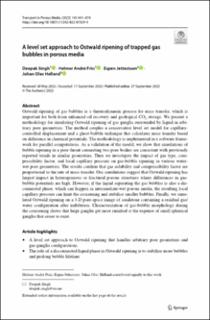| dc.contributor.author | Singh, Deepak | |
| dc.contributor.author | Friis, Helmer André | |
| dc.contributor.author | Jettestuen, Espen | |
| dc.contributor.author | Helland, Johan Olav | |
| dc.date.accessioned | 2023-04-03T10:45:18Z | |
| dc.date.available | 2023-04-03T10:45:18Z | |
| dc.date.created | 2022-11-02T12:48:17Z | |
| dc.date.issued | 2022 | |
| dc.identifier.citation | Singh, D., Friis, H.A., Jettestuen, E., & Helland, J.O. (2022). A level set approach to Ostwald ripening of trapped gas bubbles in porous media. Transport in Porous Media, 145, 441 - 474. | en_US |
| dc.identifier.issn | 0169-3913 | |
| dc.identifier.uri | https://hdl.handle.net/11250/3061770 | |
| dc.description.abstract | Ostwald ripening of gas bubbles is a thermodynamic process for mass transfer, which is important for both foam enhanced oil recovery and geological CO2 storage. We present a methodology for simulating Ostwald ripening of gas ganglia surrounded by liquid in arbitrary pore geometries. The method couples a conservative level set model for capillary-controlled displacement and a ghost-bubble technique that calculates mass transfer based on difference in chemical potentials. The methodology is implemented in a software framework for parallel computations. As a validation of the model, we show that simulations of bubble ripening in a pore throat connecting two pore bodies are consistent with previously reported trends in similar geometries. Then we investigate the impact of gas type, compressibility factor, and local capillary pressure on gas-bubble ripening in various water-wet pore geometries. The results confirm that gas solubility and compressibility factor are proportional to the rate of mass transfer. Our simulations suggest that Ostwald ripening has largest impact in heterogeneous or fractured porous structures where differences in gas-bubble potentials are high. However, if the liquid separating the gas bubbles is also a disconnected phase, which can happen in intermediate-wet porous media, the resulting local capillary pressure can limit the coarsening and stabilise smaller bubbles. Finally, we simulated Ostwald ripening on a 3-D pore-space image of sandstone containing a residual gas/water configuration after imbibition. Characterization of gas-bubble morphology during the coarsening shows that large ganglia get more ramified at the expense of small spherical ganglia that cease to exist. | en_US |
| dc.language.iso | eng | en_US |
| dc.publisher | Springer | en_US |
| dc.relation.uri | https://doi.org/10.6084/m9.figshare.19918687.v1 | |
| dc.rights | Navngivelse 4.0 Internasjonal | * |
| dc.rights.uri | http://creativecommons.org/licenses/by/4.0/deed.no | * |
| dc.title | A level set approach to Ostwald ripening of trapped gas bubbles in porous media | en_US |
| dc.type | Peer reviewed | en_US |
| dc.type | Journal article | en_US |
| dc.description.version | publishedVersion | en_US |
| dc.rights.holder | The authors | en_US |
| dc.subject.nsi | VDP::Teknologi: 500 | en_US |
| dc.source.pagenumber | 441-474 | en_US |
| dc.source.volume | 145 | en_US |
| dc.source.journal | Transport in Porous Media | en_US |
| dc.identifier.doi | 10.1007/s11242-022-01859-4 | |
| dc.identifier.cristin | 2067965 | |
| dc.relation.project | Norges forskningsråd: 294886 | en_US |
| dc.relation.project | Sigma2: nn9380k | en_US |
| cristin.ispublished | true | |
| cristin.fulltext | original | |
| cristin.qualitycode | 2 | |

